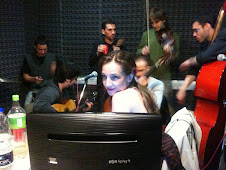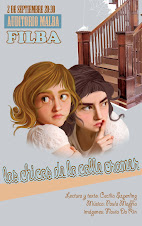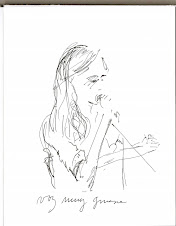sábado, 19 de noviembre de 2011
viernes, 18 de noviembre de 2011
Ta Noche! Especial Axel Krygier en Confesionario Radio
HOY Viernes 18 de nov de 22 a 24hs
Especial Axel Krygier en Confesionario Radio
87,9 fm radiouba
para escuchar online clck
la crítica como una de las bellas artes
Últimamente vengo muy desinteresada en la crítica literaria, de cine etc- Por eso me encantó esta reseña de Débora Vázquez que apareció hoy en Adn sobre Hachazos de Andrés Di Tella- Cuando la crítica completa la experiencia en vez de agujerearla-
Rastros de una biografía impensada
 El cineasta Andrés Di Tella busca plasmar en Hachazos el misterio de una elusiva figura del underground de los años setenta
El cineasta Andrés Di Tella busca plasmar en Hachazos el misterio de una elusiva figura del underground de los años setenta
Por Débora Vázquez | Para LA NACION
Un hombre que anda por la vida con una lamparita de repuesto como talismán merece una biografía. Lo mismo aquel que manipula varios proyectores en simultáneo mientras empalma viejas cintas de súper 8. Y cómo no considerar al que, provisto de una cámara, se pasea en bicicleta a la vera de un bosque para atrapar su sombra. O al que se las ingenia para revolear una cámara por arriba de su cabeza con el fin de capturar imágenes capaces de trastocar el sistema perceptivo del ojo. Todos esos hombres son Claudio Caldini, un cineasta mítico y radicalmente poético, cultor incondicional del cine underground y el protagonista ascético y furtivo de Hachazos , la ópera prima literaria del documentalista Andrés Di Tella (Buenos Aires, 1958).
Di Tella y Caldini se cruzan por primera vez en la terraza del taller de Marta Minujín, suerte de improvisado setde filmación en el que la artista y sus anteojos negros habían resuelto enterrarse en vida. Di Tella, desde fuera de cuadro, era el que le echaba tierra encima con una pala; Caldini, el responsable de registrar la performance . Treinta y cinco años después, la ironía del destino vuelve a reunirlos en una quinta de los suburbios con las armas cambiadas. Esta vez el que filma es Di Tella, y Caldini, en virtud de su oficio de jardinero, el que empuña la pala. Dos caballeros que, a pesar de encarnar concepciones antagónicas del cine -"La narración y la contemplación", "El testimonio y la imagen", "La figura y la abstracción"-, anteponen el diálogo al duelo. Y es éste el espíritu que se respira de principio a fin en el libro -y en la película homónima- de Andrés Di Tella.
Como se lee en el subtítulo, Hachazos es una "biografía experimental" basada en los apuntes que el autor redactó a mano durante los encuentros que mantuvo con Caldini a lo largo de dos años. La elección de un cuaderno de notas por sobre un grabador no es un dato menor, sino un intento de guardar la escala humana y la confirmación (o reconfirmación, para quienes hayan visto sus documentales) de que Di Tella sabe ser empático a la hora de entrevistar. En resumen, es franco, urbano, respetuoso y lo suficientemente hábil cómo para preguntarle a alguien "¿vos sos un tipo difícil?", sin ofender ni hacerse el psicólogo.
Hay algo artesanal en la factura de Hachazos que tiene que ver con la decisión estética de contar en primera persona, a modo de diario, cómo se fue haciendo el libro. Mostrar los hilos, las costuras, de una biografía hecha "de a retazos" equivale a privilegiar el proceso antes que el resultado. Lo importante para Di Tella radica en plasmar la imposibilidad de agotar un objeto de estudio y reivindicar así lo inacabado, lo azaroso y a veces fallido, el misterio de una vida, o de las varias vidas de un hombre. "Sobrevivió la dictadura militar encerrado en un jardín? Fue expulsado de un ashram, internado en un manicomio. De regreso a Buenos Aires, quedó en la calle. Durante una década de errancia, tuvo treinta y seis domicilios provisorios y abandonó el cine. En estos últimos años, recaló como cuidador de una quinta del conurbano bonaerense."
La impronta casual, reacia a la cronología, y profusa en definiciones que, en lugar de delimitar un campo, lo van desmarcando, podría suponer un descuido respecto de la estructura del libro. No obstante, si bien existe una amena sensación de deriva, el texto, lejos del naufragio, propone un montaje inteligente. Una introducción honesta, un epílogo emotivo, un intercambio epistolar potente y acotado, y una infancia que irrumpe in medias res , como un hachazo a mitad de camino, logrando que el título se vuelva nostálgico antes que filoso. En el primer capítulo el autor explica el porqué del rescate de la persona y el cine de Caldini. Dicho de otro modo, "Caldini era como uno de aquellos viejos sabios de la tribu, que llevaba en la memoria algo así como una biblioteca entera". Di Tella, para quien la literatura en general y la obra de W. G. Sebald en particular no le son ajenas, velará por "esos libros".
La obstinación de Di Tella por asociar cuestiones que a priori parecerían inconciliables queda en evidencia cuando, en un mismo capítulo, vincula la cachetada que recibe una artista amiga durante una muestra con el enredo de un pedazo de celuloide dentro de un proyector, y éstos a su vez con los fotogramas de una película de Caldini, por la sola razón de tratarse los tres de "incidentes únicos". Sin embargo, la correspondencia más ostensible no se da en el interior de ningún capítulo -relatos breves, independientes de algún modo de los que los preceden y suceden- sino entre dos de ellos, y tiene que ver con un común denominador de sus documentales: el cruce de uno o más destinos individuales con el de la historia política. Tal es el caso de la yuxtaposición de dos homenajes: el libro que el cineasta Silvestre Byrón escribió sobre el actor Miguel Riglos y la película que Caldini dedica al cineasta Tomás Sinovcic. Si consideramos que Riglos llegó a pertenecer al círculo de José López Rega y Sinovcic simpatizaba con la lucha armada, no sorprende que ambos hayan desaparecido. Dos caras de una época trágica con la que Caldini se sintió, y aún se siente, incómodo: si bien abominaba la dictadura, no comulgaba con la idea de tomar el poder por la violencia. Y el cine comprometido no le interesaba en absoluto. Una prueba incontestable es el pasaje en que se narra su asistencia a una función semiclandestina de La hora de los hornos de Pino Solanas. En lugar de celebrar el alegato de cuatro horas, como el resto de los militantes de la concurrencia, Caldini permaneció mudo. Para él, "era como estar viendo televisión". Posiblemente uno de los eslóganes más tajantes del film, "Todo espectador es un cobarde o un traidor", haya sido -junto con el clima de barbarie imperante- lo que lo precipitó a emprender una búsqueda espiritual en la India.
Tener en claro que el otro siempre es más importante es una máxima que ningún biógrafo debiera perder de vista, y Di Tella no lo ignora. La exhibición insistente de su admiración es una prueba de esto; y un buen antídoto, además, para mantener a raya el narcisismo que podría traer aparejado el abuso de la primera persona. Así como "Caldini es capaz de filmar con la seriedad de un niño que juega", Di Tella también tiene algo de niño cuando narra, como pensando en voz alta, y sin avergonzarse de preguntar lo obvio, sabiendo que de allí muchas veces provienen las mejores respuestas. "¿Y qué hacés con el archivo?", inquiere Di Tella. "¡Lo guardo! Si tuviera que pensar para qué podría servir, no guardaría nada", reconoce Caldini.
En otro diálogo en apariencia cándido, Di Tella consigue correrse del registro hagiográfico en el que suelen caer ciertos narradores de vidas ajenas. Y lo logra del modo más banal y efectivo, reconociendo la imposibilidad de hacerlo: "Yo no sé si todo lo que Byrón cuenta de Riglos es para tomar al pie de la letra? Pero sospecho que hay un poco de mitificación", especula Caldini. "Es lo que hacemos todos. No estoy haciendo otra cosa en este momento", remata Di Tella. En otras palabras, tener una aguda conciencia de su oficio le permite a Di Tella mantener los pies sobre la tierra a la hora de los elogios, reírse de sí mismo, y mostrarse vulnerable al punto de no saber si el retrato que persigue podrá o no ser fotografiado: "A veces tengo la sensación de que el verdadero Caldini no está. Como si estuviera ausente de su propia historia. O mejor, como si estuviera escondiéndose detrás de la historia que me cuenta". Únicamente en este punto podemos asegurar que Di Tella se equivoca, ya que Hachazos -ilustrado y editado con gusto- no sólo logra capturar al escurridizo "ermitaño" sino también a su sombra. Y pese a que para el autor los encuentros con Caldini se transformaron en un episodio de su vida, para el lector -producto de una de esas benévolas trampas que a veces depara la literatura- el que termina convertido en un episodio de la vida de Caldini es Andrés Di Tella.
Hachazos
Por Andrés Di Tella
Caja Negra
128 páginas
$ 65
Un hombre que anda por la vida con una lamparita de repuesto como talismán merece una biografía. Lo mismo aquel que manipula varios proyectores en simultáneo mientras empalma viejas cintas de súper 8. Y cómo no considerar al que, provisto de una cámara, se pasea en bicicleta a la vera de un bosque para atrapar su sombra. O al que se las ingenia para revolear una cámara por arriba de su cabeza con el fin de capturar imágenes capaces de trastocar el sistema perceptivo del ojo. Todos esos hombres son Claudio Caldini, un cineasta mítico y radicalmente poético, cultor incondicional del cine underground y el protagonista ascético y furtivo de Hachazos , la ópera prima literaria del documentalista Andrés Di Tella (Buenos Aires, 1958).
Di Tella y Caldini se cruzan por primera vez en la terraza del taller de Marta Minujín, suerte de improvisado setde filmación en el que la artista y sus anteojos negros habían resuelto enterrarse en vida. Di Tella, desde fuera de cuadro, era el que le echaba tierra encima con una pala; Caldini, el responsable de registrar la performance . Treinta y cinco años después, la ironía del destino vuelve a reunirlos en una quinta de los suburbios con las armas cambiadas. Esta vez el que filma es Di Tella, y Caldini, en virtud de su oficio de jardinero, el que empuña la pala. Dos caballeros que, a pesar de encarnar concepciones antagónicas del cine -"La narración y la contemplación", "El testimonio y la imagen", "La figura y la abstracción"-, anteponen el diálogo al duelo. Y es éste el espíritu que se respira de principio a fin en el libro -y en la película homónima- de Andrés Di Tella.
Como se lee en el subtítulo, Hachazos es una "biografía experimental" basada en los apuntes que el autor redactó a mano durante los encuentros que mantuvo con Caldini a lo largo de dos años. La elección de un cuaderno de notas por sobre un grabador no es un dato menor, sino un intento de guardar la escala humana y la confirmación (o reconfirmación, para quienes hayan visto sus documentales) de que Di Tella sabe ser empático a la hora de entrevistar. En resumen, es franco, urbano, respetuoso y lo suficientemente hábil cómo para preguntarle a alguien "¿vos sos un tipo difícil?", sin ofender ni hacerse el psicólogo.
Hay algo artesanal en la factura de Hachazos que tiene que ver con la decisión estética de contar en primera persona, a modo de diario, cómo se fue haciendo el libro. Mostrar los hilos, las costuras, de una biografía hecha "de a retazos" equivale a privilegiar el proceso antes que el resultado. Lo importante para Di Tella radica en plasmar la imposibilidad de agotar un objeto de estudio y reivindicar así lo inacabado, lo azaroso y a veces fallido, el misterio de una vida, o de las varias vidas de un hombre. "Sobrevivió la dictadura militar encerrado en un jardín? Fue expulsado de un ashram, internado en un manicomio. De regreso a Buenos Aires, quedó en la calle. Durante una década de errancia, tuvo treinta y seis domicilios provisorios y abandonó el cine. En estos últimos años, recaló como cuidador de una quinta del conurbano bonaerense."
La impronta casual, reacia a la cronología, y profusa en definiciones que, en lugar de delimitar un campo, lo van desmarcando, podría suponer un descuido respecto de la estructura del libro. No obstante, si bien existe una amena sensación de deriva, el texto, lejos del naufragio, propone un montaje inteligente. Una introducción honesta, un epílogo emotivo, un intercambio epistolar potente y acotado, y una infancia que irrumpe in medias res , como un hachazo a mitad de camino, logrando que el título se vuelva nostálgico antes que filoso. En el primer capítulo el autor explica el porqué del rescate de la persona y el cine de Caldini. Dicho de otro modo, "Caldini era como uno de aquellos viejos sabios de la tribu, que llevaba en la memoria algo así como una biblioteca entera". Di Tella, para quien la literatura en general y la obra de W. G. Sebald en particular no le son ajenas, velará por "esos libros".
La obstinación de Di Tella por asociar cuestiones que a priori parecerían inconciliables queda en evidencia cuando, en un mismo capítulo, vincula la cachetada que recibe una artista amiga durante una muestra con el enredo de un pedazo de celuloide dentro de un proyector, y éstos a su vez con los fotogramas de una película de Caldini, por la sola razón de tratarse los tres de "incidentes únicos". Sin embargo, la correspondencia más ostensible no se da en el interior de ningún capítulo -relatos breves, independientes de algún modo de los que los preceden y suceden- sino entre dos de ellos, y tiene que ver con un común denominador de sus documentales: el cruce de uno o más destinos individuales con el de la historia política. Tal es el caso de la yuxtaposición de dos homenajes: el libro que el cineasta Silvestre Byrón escribió sobre el actor Miguel Riglos y la película que Caldini dedica al cineasta Tomás Sinovcic. Si consideramos que Riglos llegó a pertenecer al círculo de José López Rega y Sinovcic simpatizaba con la lucha armada, no sorprende que ambos hayan desaparecido. Dos caras de una época trágica con la que Caldini se sintió, y aún se siente, incómodo: si bien abominaba la dictadura, no comulgaba con la idea de tomar el poder por la violencia. Y el cine comprometido no le interesaba en absoluto. Una prueba incontestable es el pasaje en que se narra su asistencia a una función semiclandestina de La hora de los hornos de Pino Solanas. En lugar de celebrar el alegato de cuatro horas, como el resto de los militantes de la concurrencia, Caldini permaneció mudo. Para él, "era como estar viendo televisión". Posiblemente uno de los eslóganes más tajantes del film, "Todo espectador es un cobarde o un traidor", haya sido -junto con el clima de barbarie imperante- lo que lo precipitó a emprender una búsqueda espiritual en la India.
Tener en claro que el otro siempre es más importante es una máxima que ningún biógrafo debiera perder de vista, y Di Tella no lo ignora. La exhibición insistente de su admiración es una prueba de esto; y un buen antídoto, además, para mantener a raya el narcisismo que podría traer aparejado el abuso de la primera persona. Así como "Caldini es capaz de filmar con la seriedad de un niño que juega", Di Tella también tiene algo de niño cuando narra, como pensando en voz alta, y sin avergonzarse de preguntar lo obvio, sabiendo que de allí muchas veces provienen las mejores respuestas. "¿Y qué hacés con el archivo?", inquiere Di Tella. "¡Lo guardo! Si tuviera que pensar para qué podría servir, no guardaría nada", reconoce Caldini.
En otro diálogo en apariencia cándido, Di Tella consigue correrse del registro hagiográfico en el que suelen caer ciertos narradores de vidas ajenas. Y lo logra del modo más banal y efectivo, reconociendo la imposibilidad de hacerlo: "Yo no sé si todo lo que Byrón cuenta de Riglos es para tomar al pie de la letra? Pero sospecho que hay un poco de mitificación", especula Caldini. "Es lo que hacemos todos. No estoy haciendo otra cosa en este momento", remata Di Tella. En otras palabras, tener una aguda conciencia de su oficio le permite a Di Tella mantener los pies sobre la tierra a la hora de los elogios, reírse de sí mismo, y mostrarse vulnerable al punto de no saber si el retrato que persigue podrá o no ser fotografiado: "A veces tengo la sensación de que el verdadero Caldini no está. Como si estuviera ausente de su propia historia. O mejor, como si estuviera escondiéndose detrás de la historia que me cuenta". Únicamente en este punto podemos asegurar que Di Tella se equivoca, ya que Hachazos -ilustrado y editado con gusto- no sólo logra capturar al escurridizo "ermitaño" sino también a su sombra. Y pese a que para el autor los encuentros con Caldini se transformaron en un episodio de su vida, para el lector -producto de una de esas benévolas trampas que a veces depara la literatura- el que termina convertido en un episodio de la vida de Caldini es Andrés Di Tella.
Hachazos
Por Andrés Di Tella
Caja Negra
128 páginas
$ 65
Cristina x Pola NYT
Intelligence Column
Cristina Fernández de Kirchner has proven irresistible to many Argentines. Meanwhile, the debt crisis forced Italy’s Silvio Berlusconi from office. (YVES HERMAN/REUTERS)
SETTING A NEW STAGE
By POLA OLOIXARAC
While leaders in Europe and the United States struggle with the fallout of the economic downturn and public dissatisfaction with government, Argentine president Cristina Fernández de Kirchner recently captured 55 percent of the vote to serve as president for four more years. She’s one of the most popular leaders in South America and Argentina’s first elected female president.
While leaders in Europe and the United States struggle with the fallout of the economic downturn and public dissatisfaction with government, Argentine president Cristina Fernández de Kirchner recently captured 55 percent of the vote to serve as president for four more years. She’s one of the most popular leaders in South America and Argentina’s first elected female president.
Next door, President Sebastián Piñera is coping with widespread student protests and has lost much of the support he had after the 33 Chilean miners were rescued last year. Recent polls show only 26 percent now approve of his government. Evo Morales, the president of Bolivia, is dealing with a restive indigenous population that helped put him in power but is now chafing over the rising influence of Brazil.
Meanwhile, Cristina’s second term in office was never in doubt. Her brand of populism, support of gay marriage and a hiring binge of state employees has proven irresistible to many Argentines.
Her popularity can be partly attributed to better days in Argentina, where the economy has grown for nine straight years, at rates second only to Peru in the region. But ten years after the debt default that brought down the Argentine economy, the enduring mystique of the Kirchners goes beyond the tide of stability and the spreading affluence, fueled by high commodity prices, that has coincided with their hold on the top office.
Néstor Kirchner was elected president of Argentina in May of 2003, and Cristina followed him by winning the presidential vote in October of 2007. The Kirchners found a way to update the power-couple iconography of General Juan Domingo Perón and Eva Perón in the 1940s. The Kirchners, surrounded by the national colors, waved together from the Casa Rosada balcony to the congregated masses, evoking images of the Peróns.
Cristina’s first term was tumultuous and full of drama. Like Lindsay Lohan or Britney Spears, Cristina was also prone to seducing fans and aggravating opponents. She came forth as strong but humane, resolute but emotional, much as a convincing actress would impersonate the ideal of a Latin female leader. Evita had left her successful stage and film career to serve as a politician alongside her husband; Cristina took on the presidency as her personal stage. She was always at the center of the action. She liked suspense: to the dismay of her own supporters, the public and critics, she kept her script to herself until the last minute.
As Cristina continued the bullying style of government her husband was known for, she was criticized for being too authoritative, too stubborn. In a sexist yet broadly matriarchal society, Argentines reviled this behavior, but at the same time seemed to admire her for it. Many felt in their guts that the government indecisiveness was partly to blame for the 2001 crisis.
The Peronist Party has always thrived on manipulating the media. Perón had mourned his cancer-stricken, immensely popular and equally vilified wife Evita. When Néstor Kirchner died last year, Cristina reverted to the Perón-Evita role-play. She changed her style, appearing in dignified black dresses, carefully coiffed hair, thick eyelashes and smoky eye makeup. Her voice would often break down in public when alluding to her late spouse. As the national widow, she found the role in the play that suited her best: the lone woman in power, the vestal for the nation.
But this new Evita was not calling on the working classes as Evita had in her time. Cristina was winning over the middle class, those affected by the 2001 crisis, telling them what they wanted to hear — that there was a new Argentina that would include everyone.
Is it possible that 10 years from now, a Greek or an Italian politician, who is as unknown as Cristina was in 2001, will rival her in popularity? Who will rise and take advantage of the financial crisis?
The demonstrations that rocked Argentina in 2001, when the sound of banging pots filled the air in cities across the country, were more vehement and spontaneous than today’s Occupy Wall Street movement, though they share common threads.
The Argentine assemblies called themselves anti-system. They condemned financial speculation, endorsed recycling and professed a lost faith in the capitalist system. The assemblies of angry citizens, known as “cacerolazos,” saw politicians as traitors to the state, but did not offer political alternatives to a system they felt was corrupt. Assemblies alone couldn’t bring about change; it took a savvy politicians like the Kirchners to channel the discontent.
“I don’t think I’ve ever seen a better administration,” said Carlos Daniel Sturla, 37, a lawyer from Buenos Aires. “It’s like she’s finally building the country we all wanted to see.”
No Argentine would have said that a decade ago. Is there a chance a new power couple will emerge and sift through the anger that is driving protests around the world today, inspire citizens and unite a country ?
(Pola Oloixarac’s novel “The Wild Theories” is available in French, Dutch, Italian, Finnish and Portuguese translations. She blogs at melpomenemag.blogspot.com. Send comments to intelligence@nytimes.com.)
jueves, 17 de noviembre de 2011
hermosos especiales musicales para ir cerrando el año en Confesionario Radio
CONFESIONARIO RADIO
viernes de 22 a 24hs
87,9fm radiouba
para escuchar online click
Viernes 18 de Noviembre
Axel Krygier
Viernes 25 de Noviembre
Rosario Bléfari
Viernes 2 de Diciembre
Pablo Dacal
Viernes 16 de Diciembre
despedimos el primer año de Confesionario Radio como lo empezamos
con la sorperende ORQUESTA INESTABLE que invadió el estudio y quedó como símbolo del programa-
Rosas, Rosas, Rosas!! este Sábado Flores y Poesías!!!
Declamaré Rosas Rosas Rosas!!
Confesaré al Macanudo de Liniers!!!
 |
| leeré con la genia de Paula Maffía, una reedición cortapoética de Las chicas de la calle Crámer |
que más puedo pedir para un sábado a las 7 de la tarde, la hora mágica?????
19hs Confesionario Liniers
20hs Ceci Sz y Pau-- pequeño set poesía y música-
La Cosa Mostra
En PLAZA FLORES
Etiquetas:
confesionario,
declamadora,
la cosa mostra,
Liniers,
paula maffía,
SA
miércoles, 16 de noviembre de 2011
lunes, 14 de noviembre de 2011
este viernes especial AXEL KRYGIER en Confesionario Radio!!!
VIERNES 18 de NOVIEMBRE
de 22 a 24hs
AXEL KRYGIER en
CONFESIONARIO RADIO
87,9 fm radiouba
online click
de 22 a 24hs
AXEL KRYGIER en
CONFESIONARIO RADIO
87,9 fm radiouba
online click
Salió el libro de Elsa!
Creo que digo algo por ahí- Si está bueno lo que digo es solo mérito mío y si está malo, es que Elsa me sacó de contexto, me tergiversó y no entiende nada jajaja!! gracias por mandármelo!!!
Marianela Portillo música de LIBRO MARCADO este Miércoles en Malba
Aquí MARIANELA PORTILLO acompañada por Irene Goldszer en CONFESIONARIO y AMIGOS RADIO
domingo, 13 de noviembre de 2011
LA COSA MOSTRA__este sábado a las 20hs en Plaza Flores
 |
| Fotaza de Natacha Ebers |
los geniales LA COSA MOSTRA a las 20hs
Santiago Mazzanti bajo Pedro Bulgakov - bateria--Lucy Patane -telecaster -Paula Maffia - voz y guitarra acustica
teloneras Las chicas de la calle Crámer con poesía y palabras al viento!!!
Ceci Szperling- declamación-poesía-textosPaula Maffía música--voz
Todo en Plaza Flores
Flores!! Plaza!! Música!! Palabras!! Poesía!!
Suscribirse a:
Comentarios (Atom)

























































































































































